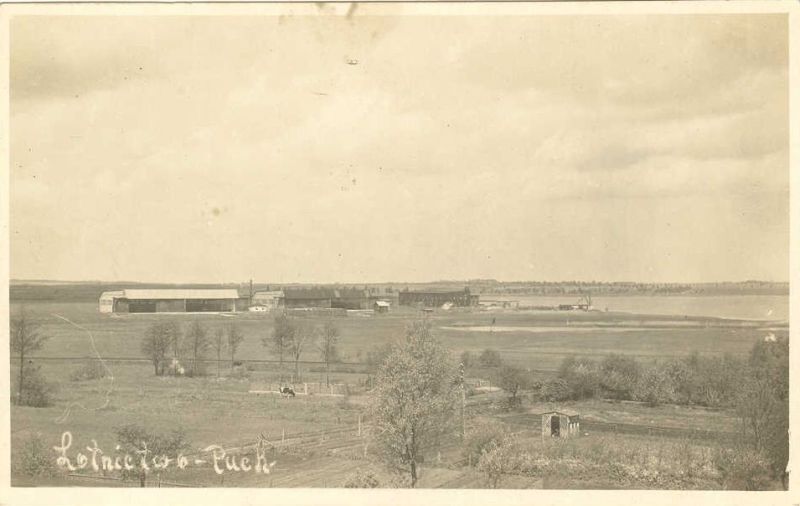 Puck (Putzig)
Puck (Putzig)
Validation date: 27 12 2011
Updated on: 27 04 2013
Views: 6308
See on the interactive map:
54°43'25"N 018°23'58"E
Runway: n/a - bay/lagoon - water
Runway: n/a - flying field - grass
Puck air station (Polish: Lotnisko Puck, German: Marine-Flugstation (or Seefliegerhorst) Putzig) was an air station 44 kilometers north of Gdansk, Poland
The air station was built in 1913 in what was then German West-Prussia (German: Westpreußen). It was home to the Marineflieger-Abteilung (Naval Air Arm) of the German Empire, founded on 1 july 1913. The headquarters of the Marineflieger was moved to Holtenau (Kiel) a year later.
A very early photograph of Marine-Flugstation Putzig, ca. 1914 (wolneforumgdansk.pl).
After the Treaty of Versailles, Putzig became part of Poland, giving the new country access to the sea. In July 1920 Puck (the Polish name of Putzig) became a Polish Naval Air Station (Polish: Baza Lotnictwa Morskiego). The new Polish navy took posession of the air station and found the Germans had taken everything from it. An experienced group of mechanics set out to find new aircraft and found two Friedrichshafens and two other aircraft. By 15 July 1920 they managed to achieve a short flight over the sea, demonstrating the Polish presence over the skies of the Baltic.
In late 1921 the air station and the naval pilot school merged into one unit, called the Naval Air Force (Lotnictwo Morskie). Ambitious plans for 274 aircraft were made, but the new country had an empty treasury. As a result only the cheapest aircraft were ordered of a type that was already being phased out in other countries. Nine Nieuport Macchi M9 seaplanes were ordered from Italy and delivered in 1921, but due to a reorganisation of the forces they were not assembled and flown until 1923. After the reorganisation the unit was known as the Naval Air Squadron (Polish: Morski Dywizjon Lotniczy.
In 1923 5 aircraft were assembled and flown, but after one broke up in mid-flight over the Bay of Puck all flying was halted. The aircraft were sent to Warsaw to reevaluate the strength of their hulls. The aircraft returned to limited service in 1925, bearing hull numbers 21-28, but were withdrawn only a year later. Subsequent purchases of seaplanes were mostly made with Latham in France.
Photos from the Interbellum show a great diversity of aircraft. Eight french 43HB3 Latham flying boats were ordered as long range patrol aircraft, which served between 1924 and 1934. Four indiginous developed aircraft, the Lublin R-XIII hydro, were ordered in 1932. Five examples of the Polish-designed RWD-17W biplane were ordered with floats in 1937 for use as trainers. Another indiginous design, the Nikol A-2 was ordered in 1939 after an unauthorised build and subsequent testing of a prototype at Puck.
War intervened the production of the latter two however. Two RWD-17Ws were never delivered to Puck and the prototype escaped from Puck to Hel peninsula and crashed there while attempting to reach Sweden. Of the Nikol A-2 prototype aircraft it is known it has been evaluated by the Germans (registered as D-GÖTZ).
A row of Friedrichshafens at Puck. As these aircraft served only briefly, this photo must date 1920-1921 (forum.eksploracja.pl).
The Friedrichshafens were replaced by Nieuport Macchi M9 seaplanes. Although they looked smart, they had a lot of problems and saw only limited service (weu1914-1918.pl).
Undated photo of Puck airfield (ww2f.com)
Puck airfield, 1926 (wolneforumgdansk.pl).
French built Latham flying boat being hoisted ashore (weu1914-1918.pl).
Polish-designed and built Lublin R-XIII floatplanes served as trainers at Puck (weu1914-1918.pl).
The Nikol A-2 prototype was designed, built and tested at Puck. After the German invasion the prototype was taken to Germany for testing and oddly registered as D-GÖTZ (weu1914-1918.pl).
By 1939 the Polish Navy had decided to by Italian again, with an order for 6 Cant 506B torpedo bombers. The Italians, however, delayed their delivery to Puck, probably under pressure from Germany. Still, in August 1939 the Polish pilots flew one Cant to Puck. In the first hours of World War II the airfield was bombed by He-111s of the Luftwaffe. The squadron seized to exist when they realised their aircraft, clearly visible sitting ducks on the water, were easy prey for the Germans. The Cant was flown to safety, but the Luftwaffe found it and bombed it. To prevent the other aircraft from capture by the Germans, the crews scuttled them at Hel peninsula by pounding them with hammers. The naval aviators then fought as Marines until the surrender of Poland in 1939.
The sole Cant 506B that the Polish Air Force did receive from Italy. It survived German bombs at Puck, but was destroyed during a bombing raid on Lake Siemieńskim (e-wspolnota.com).
As far as I can trace, the Germans did not use the seaplane base. Instead they opted to expand the airfield Rahmel-Putzig (Ramia-Puck), 17 kilometers to the south. Neither the Soviets nor the Polish bothered with the airfield after the war, again opting for the airfield near Gdynia. Although the field is no longer usable as an airfield, it seems to be remarkably complete however. If you compare the 1926 photo above with the 2009 photo below, you can still see the hangars and buildings that existed in 1926.
The location of Puck air station in 2002 (Google Earth)
The location of Puck air station in 2008 (Google Earth)